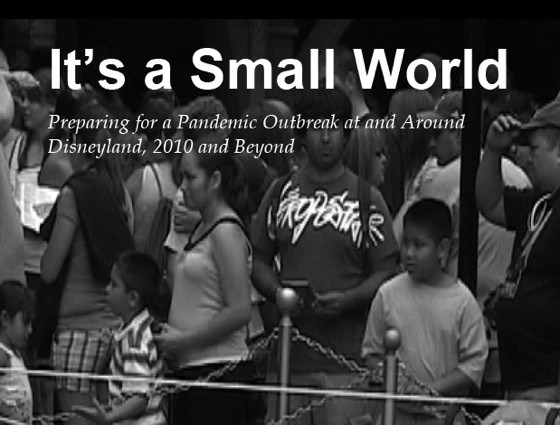
UPDATE, FEB. 19, 7:30 A.M.: The Centers for Disease Control and Prevention announced Tuesday it is adding 20 new measles cases, making the total number 141 so far this year in the U.S. Of the 20 new cases, 10 are tied to the mid-December outbreak at Disneyland, according to the CDC. Cases have now been reported in 17 states and Washington, D.C. Do you want the good news or the bad news health officials have regarding this?
]
Good: They see signs the spread of the disease is slowing.
Bad: except in California.

ORIGINAL POST, FEB. 9, 6:07 A.M.: A little more than five years ago, two University of Minnesota professors prepared a report that suggested Disneyland could be a potential amplifier for infectious diseases–a notion one of the academics claims drew objections from the entertainment giant.
Meanwhile, incoming students at University of California campuses–including the one in Irvine–will be required to be immunized against measles and other diseases beginning in 2017, the UC system announced last week.
The University of Minnesota's Robert G. Wallace of the Institute of Global Studies and Kristofer Hall of the Division of Epidemiology wrote the November 2009 report for Unite HERE Local 11, which represents Anaheim Disney Resort hotel workers.
The report stated that because the hotels and theme parks draw guests from all over the world, pathogens from viruses could reasonably reach the resort district–this in light of the swine flu H1N1 that was still circulating at that time.
As a major destination site the resort has the potential to amplify the geographic spread of the virus. Any Disney pandemic plan should account for the possibility the company's parks may contribute to the spread of influenza both locally and abroad…
The draw may produce a funnel-like effect, in which sick individuals from numerous geographically diffuse locations are brought to a specific location, in this case a resort at which thousands of employees work.
Wallace, who identifies himself as an evolutionary biologist and public health phylogeographer, writes on his blog Farming Pathogens (“Disease in a world of our own making”) that he and Hall included recommendations such as regional planning for a pandemic, employee-employer collaborative pandemic planning and an off-site employee response team.
In bringing over 15 million people through its park gates and thousands into its hotels each year, the Disneyland Resort takes on enormous responsibilities. These obligations, however, extend beyond the health and safety of its employees and customers day-to-day and on to acting responsibly under even the worst of community and public health threats. The company is not indemnified by the severity of an emergency. As one of Southern California's largest employers, Disneyland can and should act to assure its employees and their families are protected to the fullest extent possible. By doing so, the company will also help protect its customers from near and far, as well as the surrounding community.
Disney did not adopt the recommendations but instead, according to Wallace, “trotted out” the Centers for Disease Control and Prevention's (CDC) Phyllis Kozarsky “to preempt calls for long-term pandemic preparations.” Included in the Farming Pathogens' post is an email Kozarsky apparently sent to The New York Times that read:
To single out Disneyland and Disney World is not appropriate with regard to transmission of H1N1. There are too numerous to count opportunities for people to be in close spaces together, whether in movie theaters, in crowded shopping malls, on public transportation as well as during most individuals' daily activities.
“In other words, Disneyland is like anywhere else,” Wallace writes “so, against OSHA, Homeland Security, and yes, CDC recommendations, don't bother with special preparations.”
Wallace includes in his post “Mickey the Measles” a link to the full report, “It's a Small World: Preparing for the Pandemic Outbreak at and Around Disneyland, 2010 and Beyond.”
As of Friday there were 103 confirmed measles cases in California–with most linked to the mid-December Disneyland outbreak–and 32 cases in Orange County.
That's sparked alarm with the UC system, whose existing policy requires only vaccination against hepatitis B, although some individual campuses have additional requirements. The new policy will require incoming students to be screened for tuberculosis and be vaccinated for measles, mumps, rubella, chicken pox, meningococcus, tetanus, diphtheria and whooping cough.
Incoming students this fall will be notified of recommended vaccines and the plan to make them mandatory. In fall 2016, students will be “expected” to have required vaccines, but the requirement will not be enforced until the following year, when students who do not have proof of vaccinations will have their registration put on hold. The policy will allow exemptions for medical or religious purposes.
Email: mc****@oc******.com. Twitter: @MatthewTCoker. Follow OC Weekly on Twitter @ocweekly or on Facebook!

OC Weekly Editor-in-Chief Matt Coker has been engaging, enraging and entertaining readers of newspapers, magazines and websites for decades. He spent the first 13 years of his career in journalism at daily newspapers before “graduating” to OC Weekly in 1995 as the alternative newsweekly’s first calendar editor.

